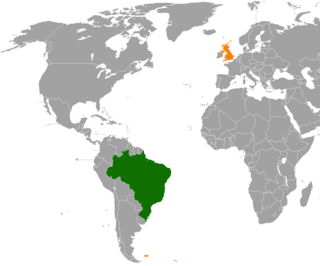Related Research Articles

Zélia Maria Cardoso de Mello served as Brazil's Minister of Economy from 1990 to 1991 under Fernando Collor de Mello. She was later married to Brazilian comedian Chico Anysio, with whom she has two children, Rodrigo and Victoria. The couple divorced in 1998.

The Kingdom of Kongo was a kingdom in Central Africa. It was located in present-day northern Angola, the western portion of the Democratic Republic of the Congo, Southern of Gabon and the Republic of the Congo. At its greatest extent it reached from the Atlantic Ocean in the west to the Kwango River in the east, and from the Congo River in the north to the Kwanza River in the south. The kingdom consisted of several core provinces ruled by the Manikongo, the Portuguese version of the Kongo title Mwene Kongo, meaning "lord or ruler of the Kongo kingdom", but its sphere of influence extended to neighboring kingdoms, such as Ngoyo, Kakongo, Loango, Ndongo, and Matamba, the latter two located in what is Angola today.

Cuíto, formerly known as Silva Porto, is a city and municipality in central Angola, capital of Bié Province. The municipality had a population of 450,881 in 2014. Projected to be the tenth fastest growing city on the African continent between 2020 and 2025, with a 5.56% growth.

The Angoche Sultanate was established in 1485 along an archipelago off the Northern Mozambique coastline. Centered on the cities of Angoche and Moma, the Sultanate also had a number of vassal territories surrounding them. They were finally removed from power by the Portuguese colonial government in 1910.

Sancho de Tovar, 6th Lord of Cevico, Caracena and Boca de Huérgano was a Portuguese nobleman of Castilian birth, best known as a navigator and explorer during the Portuguese age of discoveries. He was the vice-admiral (soto-capitão) of the fleet that discovered Brazil in 1500, and was later appointed Governor of the East African port-city of Sofala by king Manuel I. In this post, he conducted several exploratory missions in the interior regions of present-day Mozambique.
Francisca da Silva de Oliveira, known in history by the name Chica da Silva and whose romanticized version/character is also known by the spelling Xica da Silva, was a Brazilian woman who became famous for becoming rich and powerful despite having been born into slavery. Her life has been a source of inspiration for many works in television, films, music, theater and literature. She is popularly known as the slave who became a queen. The myth of Chica da Silva is often conflated with the historical accounts of Francisca da Silva de Oliveira.

Maganja da Costa District is a district of Zambezia Province in Mozambique.

Before the arrival of the Europeans, the lands that now constitute Brazil were occupied, fought over and settled by diverse tribes. Thus, the history of Brazil begins with the indigenous people in Brazil. The Portuguese arrived to the land that would become Brazil on April 22, 1500, commanded by Pedro Álvares Cabral, an explorer on his way to India under the sponsorship of the Kingdom of Portugal and the support of the Catholic Church.
The Portuguese colony of Angola was founded in 1575 with the arrival of Paulo Dias de Novais with a hundred families of colonists and four hundred soldiers. Luanda was granted the status of city in 1605. The fortified Portuguese towns of Luanda and Benguela.

Slavery in Portugal existed since before the country's formation. During the pre-independence period, inhabitants of the current Portuguese territory were often enslaved and enslaved others. After independence, during the existence of the Kingdom of Portugal, the country played a leading role in the Atlantic slave trade, which involved the mass trade and transportation of slaves from Africa and other parts of the world to the American continent. The import of slaves was banned in European Portugal in 1761 by the Marquês de Pombal. However, slavery within the African Portuguese colonies was only abolished in 1869.

The Sena people are a Bantu ethnolinguistic group with origins in northwestern region of Mozambique, Sofala Province and Zambezia Province. They are also found in Malawi and Zimbabwe near their respective borders with Mozambique.

Brazil–United Kingdom relations are the diplomatic relations between Brazil and the United Kingdom. Both nations are members of the G20, United Nations and the World Trade Organization.

The Valongo Wharf (Portuguese: Cais do Valongo) is an old dock located in the port area of Rio de Janeiro, between the current Coelho e Castro and Sacadura Cabral streets. Built in 1811, it was the site of landing and trading of enslaved Africans until 1831, with the blockade of Africa banning the Atlantic slave trade to Brazil.

Brazil–Mozambique relations are the bilateral relations between Brazil and Mozambique. Both nations are members of the Community of Portuguese Language Countries, Group of 77 and the United Nations.

Eusébio de Queirós Coutinho Matoso da Câmara was a Brazilian magistrate and politician, Minister of Justice (1848–1852) and author of one of the most important laws of the Empire of Brazil, the Eusébio de Queirós Law, which suppressed the slave trade and paved the way for its eventual eradication. He was also responsible for the Commercial Code of 1850 that still remains partly in force today.
Ana Joaquina dos Santos e Silva (1788–1859), was a Euro-African Nhara slave trader, money lender, and planter in Angola. She was the perhaps biggest slave trader in Angola, which traded with Brazil during the 1830s, and financed the expedition of Joaquim Rodrigues Graça.
Crispina Peres was an African "Senhora" slave trader, natural from Geba, nowadays Guinea-Bissau.
Dona Aurelia Correia, also known as Mae Aurelia, Mame Correia Aurelia and Madame Oralia, was a Euro-African nhara slave trader. She was titled "Queen of Orango" by Portuguese and Luso-Africans.
António Fernandes de Elvas was a Portuguese-born merchant, including investor in pepper tax farm and Asian spices. Fernandes de Elvas and his family were Marranos; that is to say Sephardic Jews who conformed outwardly as Cristão-Novo due to the demands of the Portuguese Crown but privately continued to adhere to Judaism. He was contracted by the Spanish Empire with an official asiento to provide their colonies in the Spanish Americas with African slaves from 27 September 1615 to 1 April 1623. During this time, he was the Contratodore for the Atlantic slave trade in Portuguese West Africa: Angola, Cape Verde and Guinea. He was succeeded in his position as monopolist for providing slaves to the Spanish by a fellow Marrano, Manuel Rodrigues Lamego.
Manuel Rodrigues de Lamego was a Portuguese-born merchant and slave trader active in Europe, Africa, Asia and the Americas. Rodrigues de Lamego was a Marrano. He was contracted by the Spanish Empire with an official asiento to provide their colonies in the Spanish Americas with African slaves from 1 April 1623 to 25 September 1631. During this time, he was the Contratodore for the Atlantic slave trade in Angola's Portuguese West African territory. Contrary to his predecessor as asiento holder, António Fernandes de Elvas, he was not the Contratodore for Cape Verde and Guinea. After his tenure, he was succeeded as asiento holder by Melchor Gómez Angel and Cristóvão Mendes de Sousa, while he was succeeded as Contratodore for Angola by Henrique Gomes da Costa.
References
You can help expand this article with text translated from the corresponding article in Swedish. (June 2019)Click [show] for important translation instructions.
|